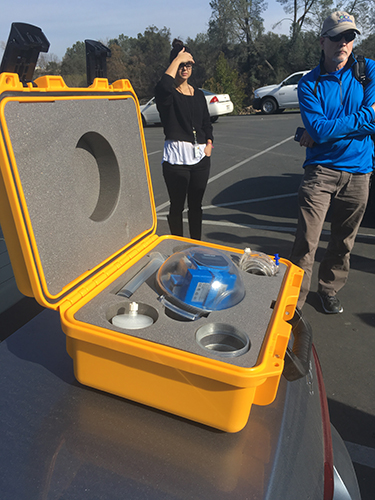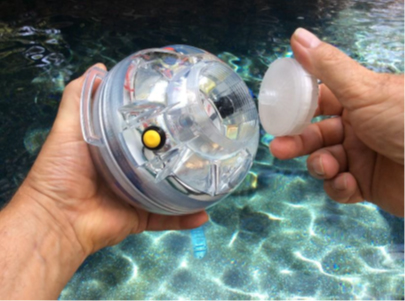New Device Measures Contamination in Water
FEB. 23, 2018 — Measuring contaminants in polluted water bodies can be a big challenge. It’s a task that OR&R staff perform often in responding to oil spills and waste sites and assessing their impacts. A common water sampling method involves collecting “Grab samples” of water into 1 liter jars and shipping them on ice to a laboratory for extraction and analysis.

On Feb. 1, OR&R staff joined representatives from California state agencies at Lake Natoma, California for a demonstration of a new, improved device for measuring contamination in water. The CLAM (Continuous Low-Level Aquatic Monitoring) apparatus developed by Analytical houses a small submersible pump and flow meter, and passes water through a solid phase extraction cartridge. Contaminants are collected by the cartridge as water passes through. The battery-operated device can be deployed for hours, even overnight, allowing large measured volumes of water to be tested. This offers several advantages: water quality measurements representing conditions over a wide time interval; an ability to detect very low concentrations; and ease of handling and transport – the retrieved cartridges may be stored for weeks or even months before shipment to the lab, unlike water samples that require lab processing within a week.
An earlier generation of the CLAM device (without a flow meter) has been previously field tested in San Diego, CA by California Office of Spill Prevention and Response, and in Folsom, CA by California Department of Parks and Recreation. In a side by side comparison of the CLAM and a 1 liter grab sample of water from the same San Diego location, the CLAM detected oil compounds at concentrations below the detection limits for the 1 liter water sample. NOAA’s National Center for Coastal Ocean Science is also currently evaluating the CLAM through controlled quality studies underway at a commercial laboratory in Texas. The OR&R is constantly investigating technologies that have potential advantages in supporting our response and assessment efforts.
For further information contact Greg.Baker@noaa.gov.

